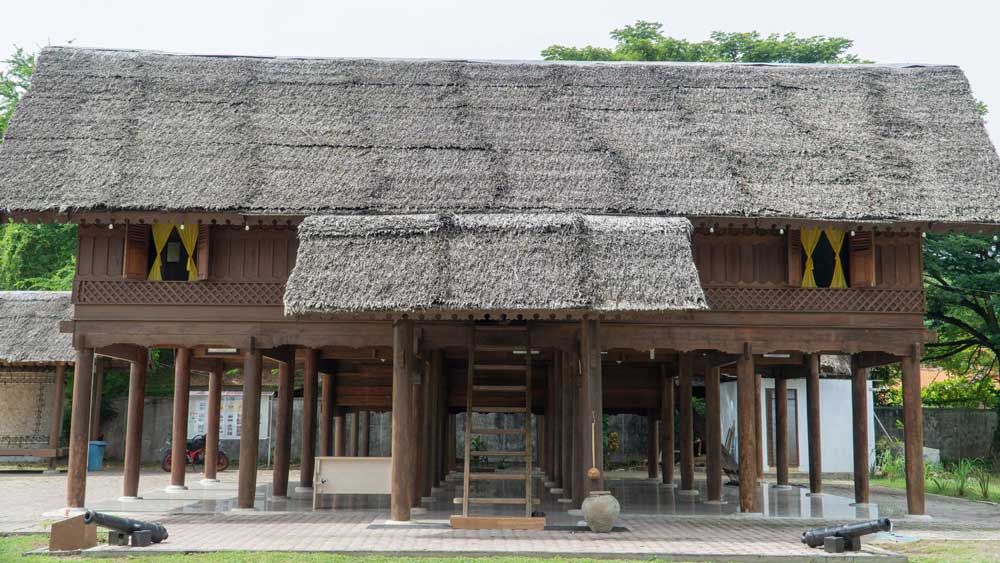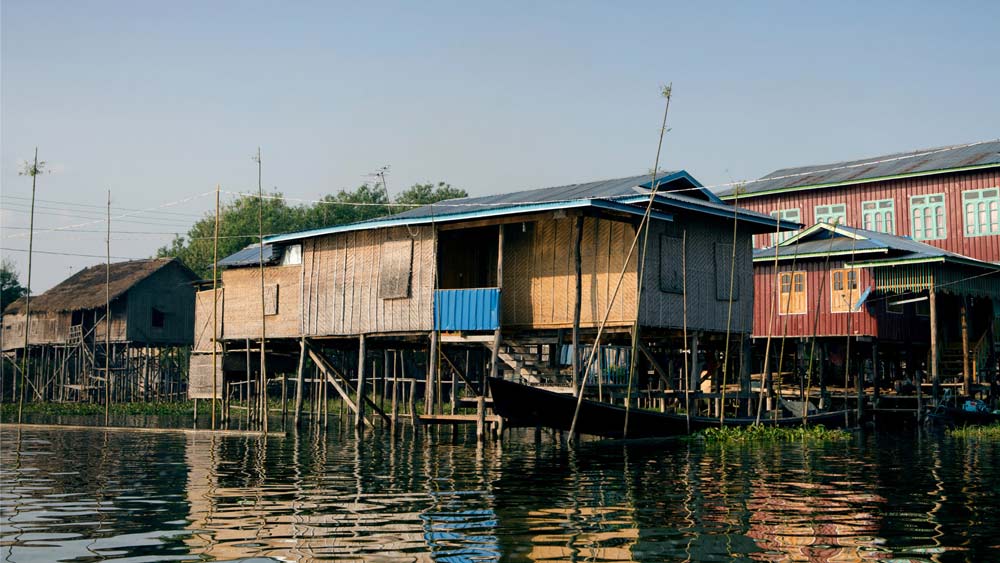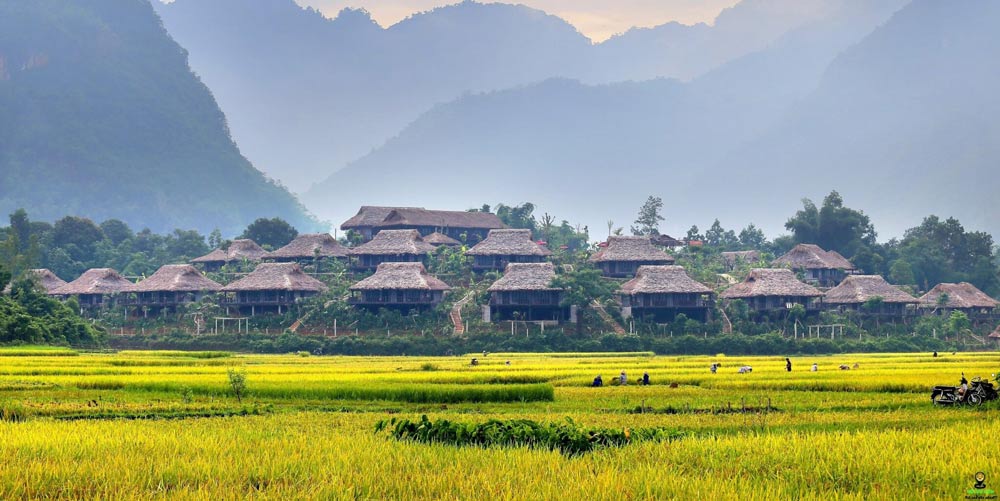Nestled in the heart of Southeast Asia, Vietnam's enchanting landscape is a harmonious blend of verdant rice paddies, bustling cities, and serene mountains, which together set the stage for an architectural palette as diverse as its natural backdrop. Among the nation's architectural treasures are the stilt houses, iconic structures that rise gracefully above the ground on slender legs. Prevalent in the mountainous regions and among the ethnic minorities, these elevated homes not only testify to Vietnam's rich cultural heritage but also to a historical ingenuity born of necessity—protecting inhabitants from flooding and wildlife. Their significance extends beyond mere functionality, serving as a living emblem of Vietnam's enduring connection to its environment and traditions.

Living in harmony with nature is an essential concept that has guided human settlement patterns and architectural designs for centuries. Among the most fascinating examples of this principle are stilt houses, which are prevalent in many parts of the world, including the Mekong Delta in Vietnam. These elevated structures are not just architectural marvels; they embody practical solutions to environmental challenges while promoting a sustainable and harmonious lifestyle with nature. Here, we explore the practical reasons behind the construction of stilt houses, focusing on their protection from floods, enhancement of ventilation and air circulation, and utility in creating space for livestock and storage.

One of the most compelling reasons for building houses on stilts is protection from floods. This is particularly relevant in regions like the Mekong Delta and other parts of Vietnam, where seasonal floods are a common occurrence. The Mekong Delta, with its intricate network of rivers and waterways, experiences annual flooding that can inundate homes and farmland. Stilt houses are elevated above the ground level, often several feet high, ensuring that living spaces remain dry and safe even during significant flooding events. This design not only protects the inhabitants and their belongings from water damage but also minimizes the risk of waterborne diseases that can proliferate during flood seasons.

The hot and humid climate of regions like Vietnam poses another challenge: maintaining comfortable living conditions inside homes. Stilt houses offer a natural solution by promoting improved ventilation and air circulation. By elevating the living quarters above the ground, these houses allow air to flow freely underneath and around the structure, facilitating a cooling effect. This passive cooling technique is invaluable in hot climates, reducing the reliance on artificial cooling systems and enhancing the comfort of the inhabitants. The open design of many stilt houses, with large windows and spacious under-house areas, further aids in the efficient circulation of air, contributing to a healthier and more comfortable living environment.

Lastly, the space underneath stilt houses is not just empty or wasted. It serves multiple functional purposes, including as a shelter for livestock and a storage area. In rural areas, particularly in agricultural communities like those in the Mekong Delta, this space is invaluable. Livestock such as chickens, goats, and even larger animals can be kept safely underneath the house, protecting them from predators and keeping them close to home for easy care. Additionally, the under-house area provides ample storage space for tools, equipment, and even crops, safeguarding these valuable resources from floods and pests. This efficient use of space exemplifies the principle of living in harmony with nature, as it maximizes the utility of the built environment while minimizing its footprint on the natural world.
In conclusion, stilt houses represent a remarkable adaptation to environmental challenges, showcasing humanity's ability to live in harmony with nature. Through their innovative design, these structures address practical concerns such as flood protection, ventilation, and space utilization, offering lessons in sustainability and resilience that are increasingly relevant in today’s changing world.

Vietnamese stilt houses, a quintessential element of Vietnam's rich architectural heritage, are marvels of traditional design and ingenuity. These structures are built with an elevated living area perched atop wooden stilts, a feature that not only protects the inhabitants from floods and wild animals but also promotes better air circulation. The materials used for these stilts are typically durable hardwoods, chosen for their strength and longevity, ensuring the house stands firm against the elements over time.
The roofs of these houses are another testament to the thoughtful design that characterizes Vietnamese architecture. Depending on the region and the resources available, roofs are made from thatch or tiles. Thatched roofs, created from local grasses or palm leaves, offer effective insulation against the heat and a natural way to cool the interior. Tiled roofs, on the other hand, are durable and provide excellent protection from heavy rains and strong sunlight, making them a popular choice in areas where these conditions prevail.
Ventilation and natural light are crucial aspects of the design of Vietnamese stilt houses. The walls are typically open or constructed with slatted wood panels, allowing for the free flow of air and plenty of daylight to enter the living spaces. This design not only keeps the house cool during the hot and humid months but also fosters a connection with the surrounding environment, allowing residents to enjoy the beauty of nature from the comfort of their home.
The size and design of Vietnamese stilt houses vary significantly across different regions, influenced by cultural traditions, climatic conditions, and available materials. In the northern mountainous areas, houses tend to have larger communal spaces to accommodate extended family gatherings, reflecting the strong communal bonds in these communities. In contrast, in the southern regions, stilt houses might be smaller and more adapted to the wetter climate, showcasing the flexibility and adaptability of this architectural style.
Each Vietnamese stilt house is a reflection of the region's culture, climate, and resources, illustrating the deep connection between the people and their natural environment. This architectural form not only serves practical purposes but also embodies the beauty and wisdom of traditional Vietnamese culture.

Stilt houses, perched gracefully above the ground, offer a truly unique and enchanting experience for travelers seeking an authentic connection with local cultures and breathtaking natural environments. These architectural marvels, often found in regions with rice paddies, rivers, and lush landscapes, invite guests to live suspended above the earth, merging traditional living with the serene beauty of the natural world.
The charm of stilt houses is not just in their distinctive construction but in the immersive experience they provide. Imagine waking up in a cozy, wooden homestay elevated above a canvas of green rice paddies stretching to the horizon or beside a gently flowing river, reflecting the sky's changing hues. This is the reality of staying in a stilt house, where every window frames a painting of nature's best works. The connection to the earth and nature is palpable, offering a peaceful retreat from the hustle and bustle of city life.
Staying in a stilt house is an invitation to dive deep into the local way of life. It's not just about finding a place to sleep; it's about becoming a part of the community, even if only for a short while. Guests have the unique opportunity to observe and partake in daily routines and customs, from the early morning preparations of meals on open fires to the evening gatherings under the house, where stories and laughter are shared. This immersion allows travelers to gain a deeper understanding and appreciation of the local culture, traditions, and the symbiotic relationship between the people and their environment.
One of the most delightful aspects of stilt house living is the elevated perspective it offers—both literally and figuratively. The architecture is designed not only to protect against flooding and pests but also to embrace the natural ventilation that comes with being raised above the ground. Guests can revel in the cool breezes that sweep through the open spaces, bringing the soothing sounds of nature and a tranquil ambiance. This elevation creates a peaceful haven where one can unwind, meditate, or simply enjoy the moment, surrounded by the gentle rustle of leaves and the distant murmur of rivers.
In essence, stilt houses present a unique blend of cultural immersion, natural beauty, and tranquility, making them an unforgettable experience for those who seek to connect with the world in a more intimate and meaningful way. Whether it's through the simple joys of living close to nature, engaging with the local community, or enjoying the serene environment, the charm of stilt houses touches every visitor, leaving lasting memories and a profound respect for the traditions that have sustained them through generations.
Stilt houses, a distinctive architectural feature across various cultures, adapt ingeniously to their environments. In Vietnam, these structures exhibit remarkable regional variations, reflecting the unique climatic and geographical challenges of each area. From the cooler northern highlands to the hot, dry central plains, and the flood-prone Mekong Delta, stilt houses embody the resilience and adaptability of local communities.

In the mountainous regions of Northern Vietnam, stilt houses are designed with steeper roofs and, in many cases, enclosed walls. This architectural style is not merely aesthetic but a practical adaptation to the colder weather prevalent in these areas. The steep roofs ensure that rain and snow do not accumulate, protecting the structure from water damage and the weight of snowfall. Enclosed walls offer additional insulation, keeping the interior warm during the chilly months. This design reflects a harmonious balance between the need for shelter from the elements and the traditional stilt house form.

Moving towards Central Vietnam, the climate shifts to hotter and dryer conditions. Here, stilt houses feature simpler designs with more open layouts. The openness of these structures facilitates air circulation, providing natural cooling to combat the heat. This architectural approach embodies the principle of living in harmony with the environment, allowing residents to stay comfortable despite the scorching temperatures. The reduced complexity of these houses also speaks to the practical need for ventilation and light in a climate that demands adaptation to persistent heat.

In the Mekong Delta, stilt houses are conspicuously built on higher stilts compared to their counterparts in other regions. This design choice is a direct response to the area's frequent flooding, as the Mekong River swells annually. Elevating the houses ensures that living spaces remain dry and safe from water damage during flood seasons. Additionally, the space underneath these elevated structures is ingeniously utilized for a variety of purposes, including storage, livestock, and even as a shaded area for relaxation and communal activities. This adaptation not only showcases the architectural ingenuity in addressing the challenges of living in a flood-prone area but also highlights the importance of community and versatility in the use of space.
Each regional variation of stilt houses in Vietnam reflects a deep understanding of local environmental conditions and cultural practices. These structures stand as a testament to the adaptability and ingenuity of Vietnamese architectural traditions, tailored to meet the diverse needs of its people while harmonizing with the natural landscape.

The architectural tradition of stilt houses, perched gracefully above land or water, continues to be a living heritage in many rural areas across the globe. These elevated structures, rooted in centuries-old traditions, not only represent an ingenious adaptation to the environment—be it for protection against flooding or pests—but also symbolize the cultural identity and continuity of the communities that built them. The use of stilt houses, particularly in regions where they have been part of the landscape for generations, remains a testament to the enduring relevance of traditional architectural practices in the modern world.
Efforts to preserve the traditional style of stilt house architecture for future generations are gaining momentum, driven by both local communities and international organizations. Recognizing the cultural and historical significance of stilt houses, these initiatives aim to safeguard the knowledge and techniques involved in their construction, ensuring that this heritage is not lost to time. Preservation efforts often encompass a range of strategies, including documentation of existing stilt houses, revitalization of traditional construction methods, and education programs designed to pass down skills and appreciation for this architectural form to younger generations.
Moreover, the preservation of stilt houses is increasingly seen as an integral part of sustainable development. By embracing the eco-friendly aspects and resilience of traditional architecture, communities are finding ways to blend ancient wisdom with contemporary needs. This not only helps in maintaining the cultural fabric of these communities but also offers valuable lessons in living harmoniously with nature.
As we move forward, the challenge lies in balancing preservation with the inevitable changes brought by modernization. It is essential to recognize that the preservation of stilt houses—and the cultural traditions they embody—goes beyond merely maintaining physical structures. It is about honoring and revitalizing the way of life, beliefs, and environmental wisdom that these houses represent. Through collective efforts, we can ensure that stilt houses continue to stand tall, not just as relics of the past, but as living symbols of cultural resilience and sustainability for generations to come.

Stilt houses, an iconic element of Vietnam's cultural heritage, stand not merely as a testament to architectural ingenuity but as living embodiments of a lifestyle in harmony with nature. These elevated structures, rooted deeply in the traditions of various ethnic groups, offer a window into the soul of Vietnam, showcasing resilience, community spirit, and an intimate connection with the environment. The cultural significance of stilt houses in Vietnam transcends their practicality, narrating stories of adaptation and unity amidst the country's diverse landscapes—from the misty mountains of the North to the verdant delta regions.
For those yearning to immerse themselves in the authentic essence of Vietnamese life, a stay in a stilt house presents an unparalleled opportunity. Beyond the unique vantage point above the ground, it invites guests into the heart of local customs, traditions, and the warmth of community living. This experience goes beyond the ordinary, offering a blend of rustic charm with the gentle whispers of nature at your doorstep.
Tourists seeking to enrich their Vietnamese journey with this distinctive accommodation will find a variety of resources to guide them. Websites dedicated to cultural tourism, travel blogs focusing on Vietnam, and platforms specializing in unique lodgings offer comprehensive listings of stilt house homestays. These resources provide insights into the different regions of Vietnam where stilt houses are prevalent, each offering a unique backdrop and local experiences. From the serene landscapes of Sapa to the vibrant cultures of Mai Chau, travelers can select a homestay that resonates with their adventurous spirit and desire for authenticity.
In conclusion, embracing the opportunity to stay in a stilt house is more than just choosing a place to sleep; it's about choosing to experience Vietnam in a manner that is as enriching as it is genuine. As we encourage tourists to venture into this captivating aspect of Vietnamese culture, we invite them to step into a world where every sunrise and sunset seen from the stilts is a reminder of the beauty and depth of Vietnam's heritage.
Fascinated by the unique charm of Vietnamese stilt houses? Dive deeper into Vietnam's rich cultural heritage with our Bests Of Vietnam tour package, where you'll experience the authentic beauty and traditions of this captivating country.
Our tailored tour packages offer a bespoke journey through Vietnam, allowing you to discover the essence of its culture and landscapes according to your own preferences and pace.